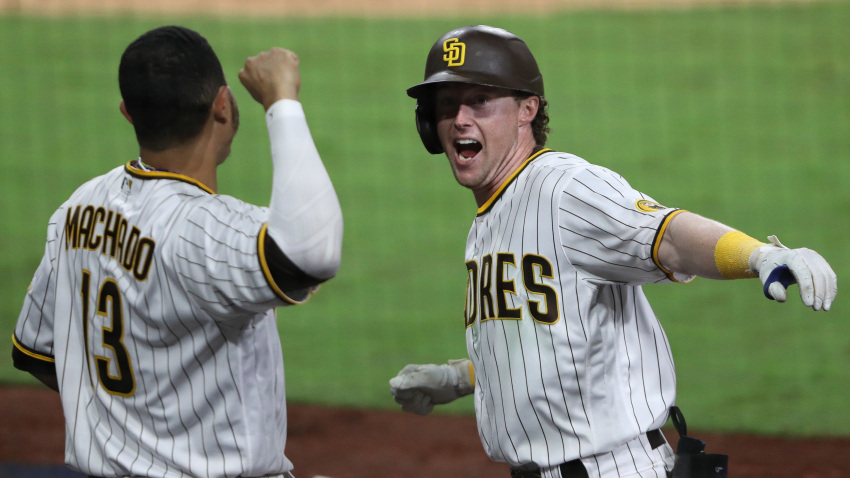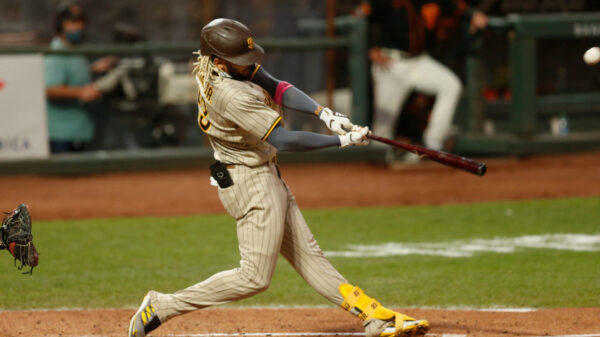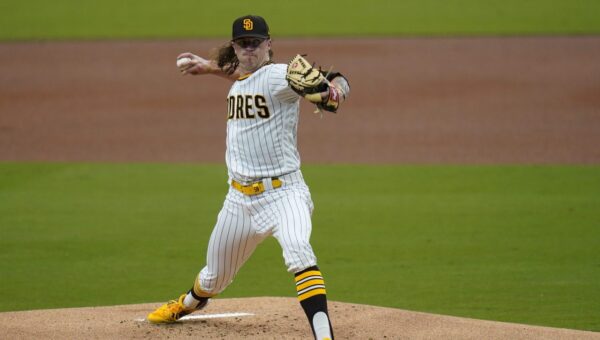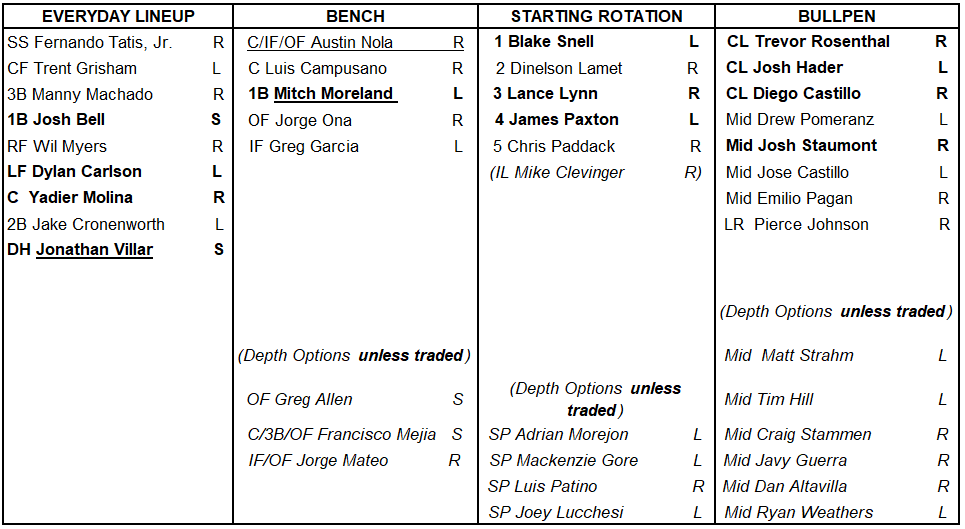Going all in: San Diego Padres off-season plan No. 3

Credit: Photo by Sean M. Haffey/Getty Images

TATIS:
In this third off-season revamp, let’s start with locking up Fernando first.
Let’s get crazy. At one extreme, the Padres could go full Kool-Aid and sign him to a 20-year, $800 million deal, taking him through age 41. Padre for life and all that. The AAV of $40 million might look pretty good when the contract’s done, actually. At the other extreme, they could choose not to offer him a deal and play the arbitration game, trying to beat the market when his control elapses. Both are foolish. Ideally, for both parties, an extension buys out his remaining years of control, and Tatis, Jr. feels an allegiance to the organization’s handling of his contract status that makes a second career-fulfilling contract a probability. Everyone wins.
So, what’s the number? Luis Robert (6/$50M) and Eloy Jimenez (6/$43M) are maybe the closest approximations, but they signed prior to even playing Major League caliber games. Tatis, Jr. has performed at a higher level than they have while doing it against Major League talent longer. On the other hand, his precipitous drop in performance down the stretch in 2020, as well as his injury history, may limit his salary ceiling this go around.
San Diego controls his rights for only four more seasons. I propose an eight-year, $100 million deal. Tatis, Jr. gets a guarantee that injury or performance dips can’t take away, and he emerges at age 30 with earning power left. Mike Trout recently signed an age 29 contract at 12 years/$429.5 million. In eight years, Tatis Jr. could still pull a roughly 10-year/$450 million second long-term contract, ultimately moving to a corner outfield or DH role if needed. The Padres gain double the control of a marquee talent at a manageable AAV of $12.5 million. Most importantly, the left side of the infield is set as one of the elite of all-time for the foreseeable future in San Diego, and after a period of success, there should be reason for both parties to keep him in San Diego. The first two years are at $10 million while the last two years are at $15 million.
FERNANDO TATIS, JR. (EXTENSION), SHORTSTOP: 1 year/$10 MILLION + 7 YEARS OF CONTROL
$85M-$9.4M=$75.6M
CATCHER:
At catcher, the Padres arm themselves with a quality Nola/Campusano mix in theory. Francisco Mejia gets another opportunity to earn a roster spot in a utility type of role, and this positional threesome costs next to nothing. It’s an almost perfect scenario in the talent/cost/production matrix. However, if there is legitimate concern over Campusano’s immediate future, or it appears that the alleged infractions could limit his season in some significant way. The team may have to reluctantly alter the personnel. Mejia was the most undisciplined batter in the organization in 2020 in a year where literally everyone else became more disciplined, leading to more runs per game. If standing pat is the intent, it’s time to rethink it.
If only one of the best catchers of all time happened to be available, and that catcher could still play at a level that raises the entire Padres roster in knowledge and accountability. If, in this scenario, both Hosmer and Pham were gone, leadership would be in need. The best choice is clear-cut: Yadi. He’s 38, you say? I know. But, it’s not just that his past is great, but he was the toughest out in the Cardinal playoff series lineup a few months ago. He can still swing it, catch it, and throw it well enough, and he’s a once-in-lifetime-player who elevates managers to win Manager of the Year awards. Ask Mike Schildt. The bar for the entire team is raised with his signing, and he won’t have to play every day. Austin Nola is at least one quality option, and when he’s not catching, Nola (who is relatively new to the catching position) can DH or play around the diamond for a few years while being tutored by one of the best ever. It’s the perfect scenario for both players and the team. Campusano and Mejia will grow or have to go.
It’s likely that Molina and his camp are testing the contractual waters at the behest of the Cardinals. It would be hard to imagine him in a different uniform. But, his case for the Hall would be strengthened by bringing the Padres to a title. It’s the perfect scenario, and I don’t think twice about a 2-year contract that cuts him from St. Louis. He’s ruled the roost in STL for nearly two decades. Can you remember a year the Cardinals weren’t in it during that span? He’s almost a unicorn, so he’s worth even a $10 million a year cost at age 40.
YADIER MOLINA, CATCHER: 2 years/$10 MILLION per
$75.6M-$10M=$65.6M
FIRST BASE:
First base is in flux after jettisoning Eric Hosmer’s contract in this “All In” scenario. There has to be a better value to make such a move. There are three veteran possibilities: free agent, Carlos Santana (maybe); Chicago Cub trade piece, Anthony Rizzo (probably); and my choice, Pittsburgh Pirate, Josh Bell (likely). Bell is a buy-low candidate who the Pirates may want to hold onto for a while. But, in an “All In” mode, whatever it takes is done, and frankly, Bell’s precipitous dive at the end of 2019 and his pedestrian 60-game season in 2020 should make him affordable. At a projected $6.1M in 2021 with an additional year of control, Bell’s ceiling overrides his potential floor as neither cost nor term make his acquisition a concern. Why Bell? Even in an up and down 2019, Bell’s 37-homer .277/.367/.569./936 slash line makes him a potential MVP candidate, switch-hitting first baseman for a quarter of Hosmer’s cost.
JOSH BELL, FIRST BASEMAN: 1 YEAR/$6.1 MILLION + 1 year of control
$65.6M-$6.1M=$59.5M
BULLPEN:
The bullpen, comprised of several good arms that profile mostly as middle relief sans Drew Pomeranz, who had a dominating 2020, deserves the significant attention. The back end of the bullpen, long a strength in San Diego, lacks a true stopper, and swing and miss relief arms may make or break 2021. There are some appealing options on the free-agent market. The most useful options are likely Brad Hand (2/$14M), Trevor Rosenthal (2/$14M), and Kirby Yates (1/$5M). Each former Padre has had success in Petco. But, Yates’s struggles in 2020 before his season-ending injury do not inspire hope in the type of complete physical and performance turnaround needed for a championship run. Hand can be approximated with lower-cost talent. But, Rosenthal is the kind of stopper that all teams need.
For value and ceiling, the best fit for this philosophy comes in exploring the trade market because most short term free-agent contracts are stopgaps. Only AJ and the teams involved know what will be fair deals, so I won’t even suppose specifics. But, there is no way the second or third industry-rated farm system can’t acquire them.
Targets are potentially many. Three pitchers sit at the top of the list. Kansas City Royals right-hander, Josh Staumont, has two pre-arb years and five total years of control. Tampa Bay Rays right-hander, Diego Castillo, has another pre-arb season with four years of control. To balance out the back end, Josh Hader, the tremendous left-hander for the Milwaukee Brewers, has a $5.6M contract in 2021 with two additional years of control. These moves will cost a lot, but the point is less about those deals and more about making the move to acquire these pieces to win today per an “All In” philosophy. These additions would give San Diego five elite back of the pen options, when including Drew Pomeranz, that could have a numerical pecking order or be used a la the Rays bullpen of 2020 with many players getting saves. The system would rely on matchups and being fresh more than attaching a player to an inning.
TREVOR ROSENTHAL, RELIEVER: 2 years/$7 MILLION per
DIEGO CASTILLO, RELIEVER: $576,000 1 pre-arb year + 3 years of control
JOSH HADER, RELIEVER: 1 year/$5.65 MILLION + 2 arb years
JOSH STAUMONT, RELIEVER: $565,000 + 4 years of control
$59.5M-$14M=$45.5M
STARTING PITCHING:
The rotation could easily stay as is, banking on the rise of players named Luis Patino, Adrian Morejon, MacKenzie Gore, or Ryan Weathers. But, with Mike Clevinger’s injury, Preller is almost goaded into change. With an “All In” philosophy, though, some of these pieces (all?) could be moved. It’s very possible one or more of these pitchers matures into a fixture of the Padres rotation as early as 2021. The problem is they all have significant improvements to make, and Covid-19’s limitations make their growth a less-than-projectible bet in a year where practice and development are hampered. Minor league reorganization and disbanding is in full flex. Also, the current returning rotation options are all balky to some degree. Additionally, we’ve decided to trade 2020 staff savant Zach Davies. The revamping of this position will likely make or break 2021.

For starters, Lance Lynn from the Rangers would be a strong choice. With only one year of control and a fitting base salary, he becomes a reliable innings-eater, capable of play-off caliber performance. But I think another move is needed. Lance is likely only a one-year add, and he doesn’t give the Padres a lefty either.
A second acquisition comes from the free-agent market: James Paxton. Unlike proclaimed free-agent prize Trevor Bauer, whose outlier season (2020) yielded a deserved Cy Young Award, Paxton, whose highest season ERA was 3.90 until his outlier 2020 (6.64), brings under-the-radar greatness to the mound. After rehabbing from injury, Paxton is nearly okayed to throw for teams by agent Scott Boras, so he must be healthy enough to do it. Getting the Big Maple out of the Bronx may pay big dividends on a shorter-term, mid-level contract, all the while balancing the rotation with a lefty. He’s projected to earn a two-year/$30M contract if healthy.
For an “All In,” prospects, including No. 1 pitching prospect MacKenzie Gore, are on the table. With this philosophy, six years of control of what may be in a guy like Gore, who wasn’t developmentally ready to even take a start during the postseason, is not as valuable as three years of a Cy Young winner like Blake Snell. Snell seems to have tired of the almost maniacal analytics-first focus of his Rays. He’s gettable, and his three seasons, starting at $11.1M in 2021, are probably more than Tampa will choose to pay. These three additions give the Padres a championship-worthy 2021 starting rotation, and Lynn’s likely exit after the year is filled easily by Clevinger.
BLAKE SNELL, STARTING PITCHER: 1 year/$11.1 MILLION + 2 YEARS OF CONTROL
LANCE LYNN, STARTING PITCHER: 1 year/$8 MILLION base salary
JAMES PAXTON, STARTING PITCHER: 1 year/$15 MILLION + 1 YEAR OF CONTROL
$45.5M-$34.1M=$11.4M
LEFT FIELD:
Leftfield is wide open since we traded Pham in this philosophy. There are internal options. But, with the “All In” philosophy, there are better assets to sift through. With the emergence of other options in Tampa, left-hand hitting Austin Meadows may be had, as he had a slump of a year though his ceiling is high. In San Francisco, Mike Yastrzemski went off with a tremendous season, and he carries many years of control. In Boston, could Andrew Benintendi be pried after poor performance? Ian Happ, Alex Kiriloff, Dylan Carlson, Lourdes Gurriel, Brandon Nimmo, and Jeff McNeil are potential targets as well.
But, if the farm is currency, and San Diego has plenty of it, the at-bats Carlson gave during the playoffs against the Padres as a clean-up hitter showed his talent and moxie. He only hit .200 in 110 at-bats, but it’s just a matter of time. He’s controllable through 2027, and the switch-hitter from Elk Grove can become a fixture in the outfield in his home state. His acquisition seems akin to a Grisham add both for the near term and the long term.
DYLAN CARLSON, OUTFIELDER: 1 year/$569,000 + 6 years of control
$11.4M-$569,000=$10.8M
=$169.2M
That’s 10 players (and a Tatis, Jr. extension) coming in under budget. Depth and playoff quality reign. Youth and playoff experience abound. And, most importantly, sticking to the “All In” philosophical concept: this group is now retooled, ready to give a legitimate run at the World Series title.
DESIGNATED HITTER:
The designated hitter position may not return to the National League this year, and even if it does, the preceding decisions give the Padres a number of possible options. Campusano, Carlson, Nola, Jorge Ona, and Yadi all could claim the spot on this roster as constructed if the right circumstances existed. The team would be “under budget” and be ready to hunt bear. But, if the organization wanted to add one more piece, if they wanted to address the designated hitter role, if they wanted to really go “All In,” they’d splurge for one (or actually two) last roster piece(s).
If another piece were needed, it would be a left-handed bat that has all-around hitting potential (average, power, grinder, clutch). They’d have to be cheap, and they’d have to fit. Though I’m sure the Red Sox will at least consider him, that perfect fit is now-former Padre Mitch Moreland, and his $3 million tag from 2020 will likely be lower, so this roster could add potentially him for a $2M cost.
If truly “All In,” I’d ink one more veteran bat with multiple position value at a reasonable cost. Jonathan Villar would strengthen the bench and make flexibility a premium strength of the Padres. He’s a switch-hitter who can play infield and outfield both up the middle and in the corners. He can hit the ball out of the park and steal a base. He’a a human jack-knife on a baseball diamond.
MITCH MORELAND, Designated Hitter/First Baseman: 1 year/$2 MILLION
JONATHAN VILLAR, Utility (Infielder/Outfielder): 1 year/ $6 MILLION
$10.8M-$8M=$2.8M
=$177.8M
The roster and lineup following this philosophy may look as follows:
2021 San Diego Padres Lineup and Roster: The All-In Philosophy
Additions are shown in bold (Depth options shown in italics), Potential Platoon shown underlined
Could this “All In” crew earn a title? Free agency would produce Molina, Villar, Moreland, Paxton, Rosenthal. Meanwhile, trades would have to be orchestrated to acquire Bell, Carlson, Snell, Lynn, Hader, Castillo, and Staumont. The prospect cost would be tremendous possibly, but the roster would be as good or better than any in the game, and it would only cost $18 million more than the 2020 version was set to cost. Is there a price too great for the reality of taking the big cake, especially for the first time ever?
We’ve now explored three different philosophies. First, we explored the “Get the Band Back Together” concept that essentially believed the 2020 team, with a fully healthy rotation, was good enough to win it all. Second, we explored the “Prospects are Cool; Parades are Cooler” concept and its belief that many prospects won’t develop, so why not spend them like cash to buy established big leaguers. Finally, we’ve now explored a third philosophy that says let’s accumulate the greatest group of talent possible for a one or two year run to legitimately win a trophy.
Which philosophy is best? I don’t know. I’m a believer in a long window. I desire a 15-20 year run like the “90s Braves” had. Atlanta won 14 division titles in a row. They appeared in five World Series. They only won it all once, so they’re almost disrespected. But, who’s to say a 15-20 year Padre run fed through a draft and develop, prospect flow chart wouldn’t win three or four out of five. That requires an elite draft and development proficiency. Can they do that?
The 2015-16 Kansas City Royals had an amazing two-year run, including back-to-back World Series appearances, but they fell through mediocrity to rock bottom almost immediately after. Both paths yielded one trophy, and that is yet a dream in Padre-land.
I tend to take the long game approach, but as I said at the beginning, I couldn’t care less how it happens. I just dream of it happening, and regardless of the off-season plan Preller and Co. devise, encourage all Padres fans to simply dream on till the dream comes true.
M. Robert Klemesrud, born and currently residing in the great state of Iowa, is an educator of 25 years. Having studied journalism at the University of Iowa, played baseball in the Missouri Valley, and followed the Padres religiously for over 30 years, he has found the perfect place to align some of his passions at East Village Times.

For the most part, Im inline with Tom . Look extending Fernando does nothing in making the 2021 Padres better. It would however limit 2021 and the following two years on making the subtle tweaks Tom talks about. The genie is out of the bottle, they aren’t getting a hometown discount. Ride the last year of pre arb in 2021 and even 2022 when he will probably have a record setting first past through arbitration. Cody Bellinger holds that claim at 11.5M and im sure someone will raise it in 2021. Even with that it still puts Tatis 2022 salary around 13 to 15M. Hes still under the Padres control so let the system work to their advantage. You want to know how you increase the chance that Jr extends with San Diego? You focus on the pitching which led to their playoffs run prematurely. You sort of done this but neglecting to isolate what in house options would still be Padres. You want to land names like Lynn, Snell, Paxton, Hader, Staumont, Castillo, Carlson, and Bell. The current farm would be significantly impacted as well as the long term sustainability of being competitive. Morejon, Gore and Weathers need to Padres.
Peter Seidler to date hasn’t said theirs no budget for Trevor Bauer to my knowledge. More realistic would Lance Lynn, James Paxton or anyone of a half dozen arms looking to rebound would focus on San Diego as an ideal place to do so. If they can land a Snell, or Sonny Gray and keep the three pitchers above, have at it. There were arms that came back in the deadline deals this season that will come into play with the bullpen. Returning arms from injury in Espinoza, Diaz and Lawson will fall back into place. New toys like Wilcox, Lange and Haynes will finally start their professional careers. There is so much we dont know that the Front office does.
2021 payroll with estimated arb numbers sits about 130M. 2022 is 96M pre arb but with names like Tatis, Lamet Strahm and Pagan hitting arbitration the number will be about the same as 2021 while losing Stammen, Johnson, Pham and Davies to FA. 2023 is when there is a significant drop to 58M pre arbitration as Myers will be gone and Hos drops to 13M, plus losing Clevinger and Strahm. Let Colorado be the cautionary tale for San Diego. Didnt anyone in their right mind think there was a chance to see a 2021 Rockies roster where there was no Arenado, Story, Dahl et al.
The closest approximation to a Fernando Tatis contract would be the Ronald Acuña contract, which was signed after he reached the show, and was for 8 years, $100 MM, for an AAV of $12.5MM
Hard to know what to make out of commentary like this. Willful suspension of rationality is not a substitute for analysis.
1) Sure, extend Tatis. But he’s not signing for 6/$43mil, that’s not even worth speculating.
2) There is no reason to trade Davies. Teams do not get better by trading players like this.
3) Pham will not be traded to St. Louis, they traded him away once already.
4) Your section on Hosmer is beyond embarrassing. He has no trade value. He might be the most overrated player in all of baseball. He’s terrible and overpaid. A team would have to be out of its mind to want him. SD is stuck with him, unless they arrange a bad contract swap.
5) Avoid Realmuto? He’s only the best catcher in the game, so yeah, we should stick with a converted INF and scrubs instead of upgrading. You want to go “all-in” yet you resist the one clear elite player available. And your solution is to sign Molina? Maybe sign McCann as an alternative. But Molina, definitely not.
You do not take a 100-win team (which is what they would have been with a full season) and make drastic, reckless moves. You make careful improvements where needed (such as adding a starter like Paxton, and relievers like Rosenthal and Hand) while keeping open the option to making a big upgrade (such as Realmuto) if possible.